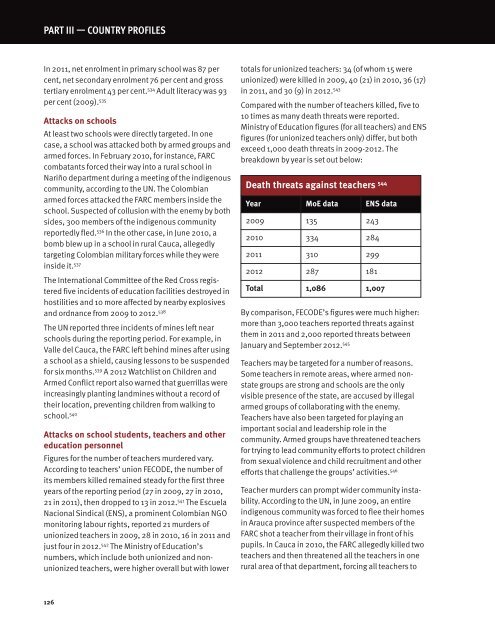Create successful ePaper yourself
Turn your PDF publications into a flip-book with our unique Google optimized e-Paper software.
PART III — COUNTRY PROFILeS<br />
In 2011, net enrolment in primary school was 87 per<br />
cent, net secondary enrolment 76 per cent and gross<br />
tertiary enrolment 43 per cent. 534 Adult literacy was 93<br />
per cent (2009). 535<br />
Attacks on schools<br />
At least two schools were directly targeted. In one<br />
case, a school was attacked both by armed groups and<br />
armed forces. In February 2010, for instance, FARC<br />
combatants forced their way into a rural school in<br />
Nariño department during a meeting of the indigenous<br />
community, according to the UN. The Colombian<br />
armed forces attacked the FARC members inside the<br />
school. Suspected of collusion with the enemy by both<br />
sides, 300 members of the indigenous community<br />
reportedly fled. 536 In the other case, in June 2010, a<br />
bomb blew up in a school in rural Cauca, allegedly<br />
targeting Colombian military forces while they were<br />
inside it. 537<br />
The International Committee of the Red Cross registered<br />
five incidents of education facilities destroyed in<br />
hostilities and 10 more affected by nearby explosives<br />
and ordnance from 2009 to 2012. 538<br />
The UN reported three incidents of mines left near<br />
schools during the reporting period. For example, in<br />
Valle del Cauca, the FARC left behind mines after using<br />
a school as a shield, causing lessons to be suspended<br />
for six months. 539 A 2012 Watchlist on Children and<br />
Armed Conflict report also warned that guerrillas were<br />
increasingly planting landmines without a record of<br />
their location, preventing children from walking to<br />
school. 540<br />
Attacks on school students, teachers and other<br />
education personnel<br />
Figures for the number of teachers murdered vary.<br />
According to teachers’ union FECODE, the number of<br />
its members killed remained steady for the first three<br />
years of the reporting period (27 in 2009, 27 in 2010,<br />
21 in 2011), then dropped to 13 in 2012. 541 The Escuela<br />
Nacional Sindical (ENS), a prominent Colombian NGO<br />
monitoring labour rights, reported 21 murders of<br />
unionized teachers in 2009, 28 in 2010, 16 in 2011 and<br />
just four in 2012. 542 The Ministry of Education’s<br />
numbers, which include both unionized and nonunionized<br />
teachers, were higher overall but with lower<br />
totals for unionized teachers: 34 (of whom 15 were<br />
unionized) were killed in 2009, 40 (21) in 2010, 36 (17)<br />
in 2011, and 30 (9) in 2012. 543<br />
Compared with the number of teachers killed, five to<br />
10 times as many death threats were reported.<br />
Ministry of Education figures (for all teachers) and ENS<br />
figures (for unionized teachers only) differ, but both<br />
exceed 1,000 death threats in 2009-2012. The<br />
breakdown by year is set out below:<br />
Death threats against teachers 544<br />
Year MoE data ENS data<br />
2009 135 243<br />
2010 334 284<br />
2011 310 299<br />
2012 287 181<br />
Total 1,086 1,007<br />
By comparison, FECODE’s figures were much higher:<br />
more than 3,000 teachers reported threats against<br />
them in 2011 and 2,000 reported threats between<br />
January and September 2012. 545<br />
Teachers may be targeted for a number of reasons.<br />
Some teachers in remote areas, where armed nonstate<br />
groups are strong and schools are the only<br />
visible presence of the state, are accused by illegal<br />
armed groups of collaborating with the enemy.<br />
Teachers have also been targeted for playing an<br />
important social and leadership role in the<br />
community. Armed groups have threatened teachers<br />
for trying to lead community efforts to protect children<br />
from sexual violence and child recruitment and other<br />
efforts that challenge the groups’ activities. 546<br />
Teacher murders can prompt wider community instability.<br />
According to the UN, in June 2009, an entire<br />
indigenous community was forced to flee their homes<br />
in Arauca province after suspected members of the<br />
FARC shot a teacher from their village in front of his<br />
pupils. In Cauca in 2010, the FARC allegedly killed two<br />
teachers and then threatened all the teachers in one<br />
rural area of that department, forcing all teachers to<br />
126


